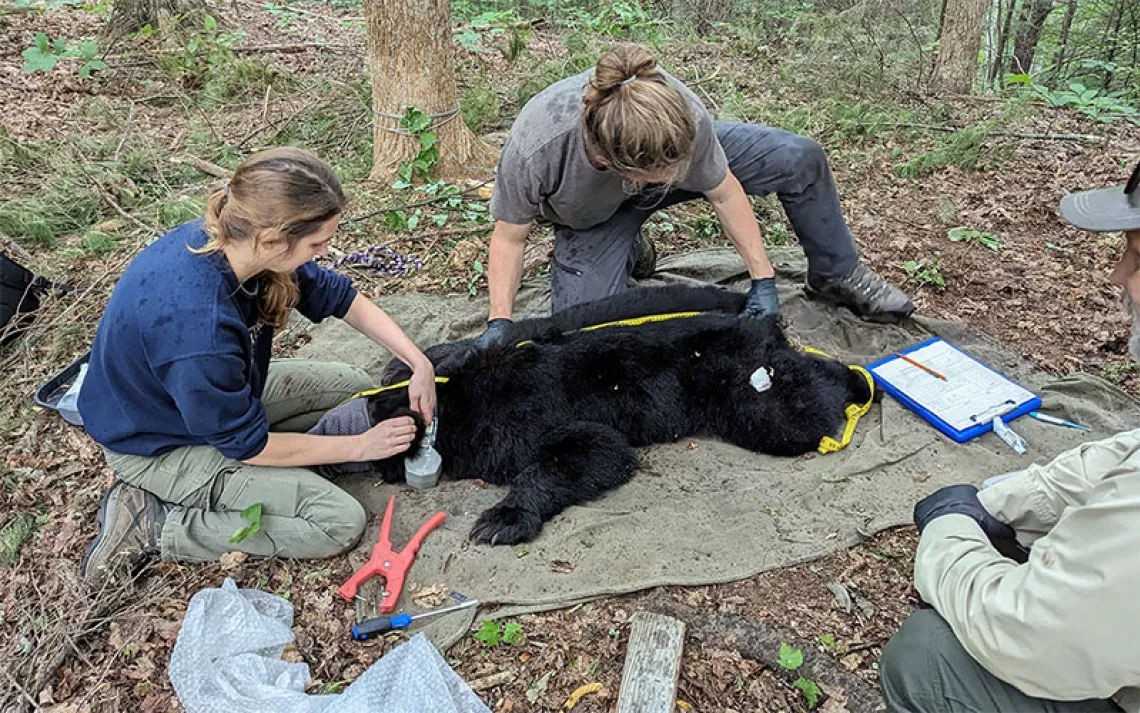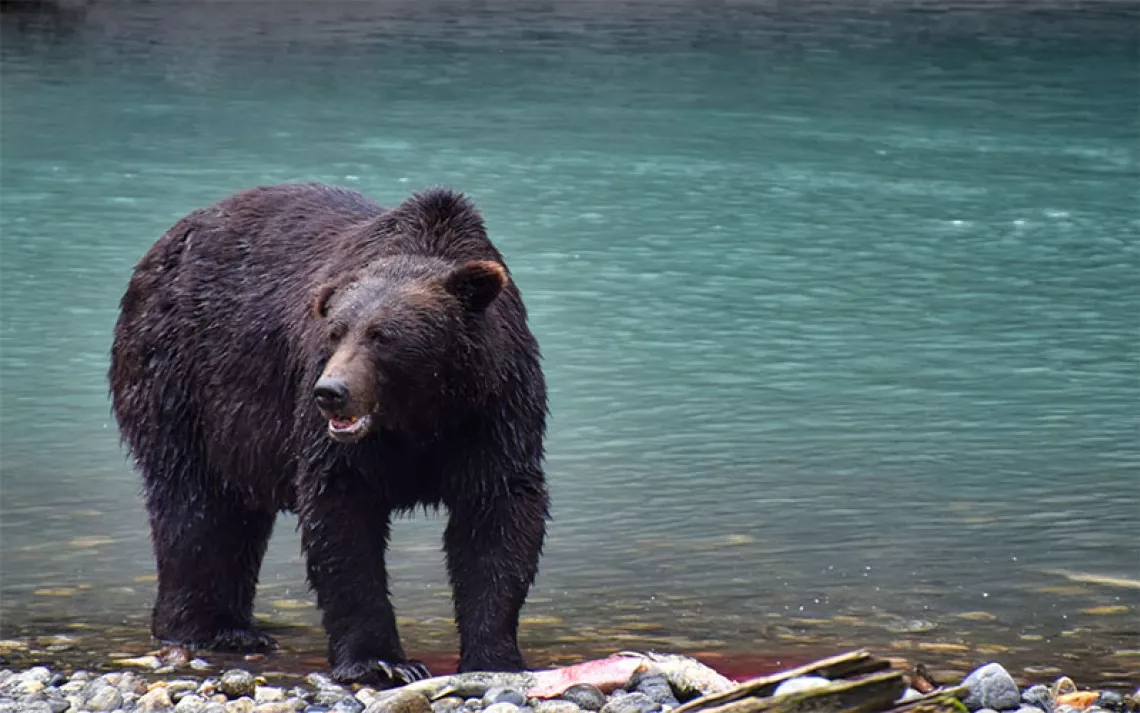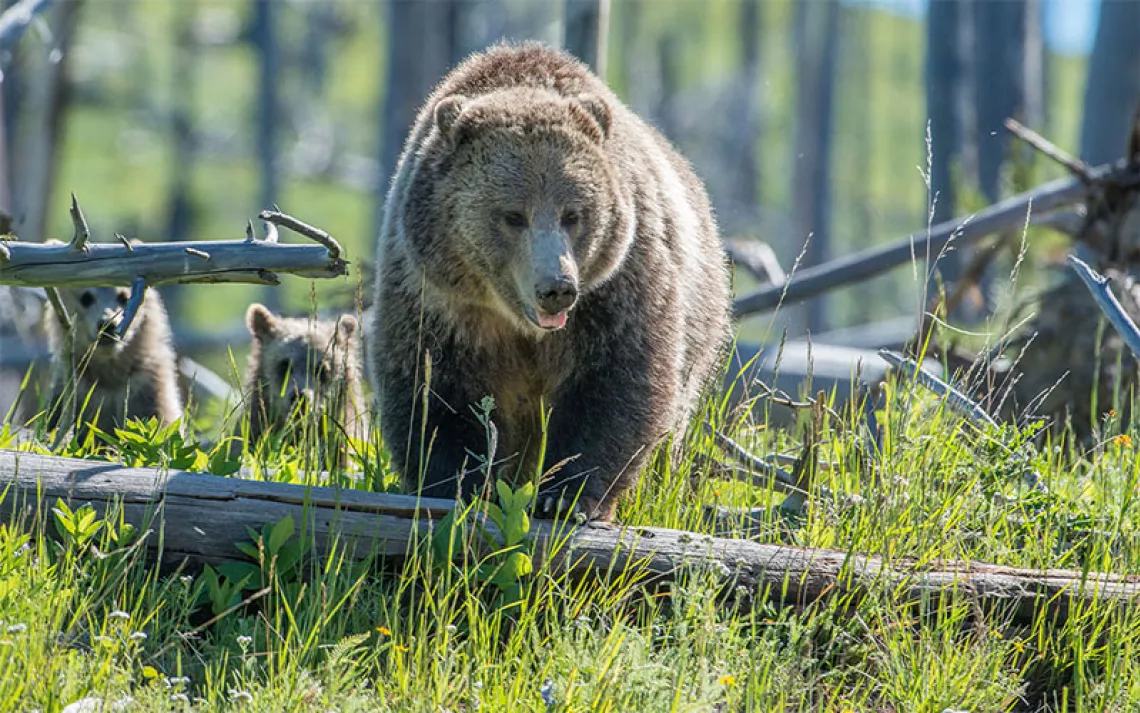A Bear for All Seasons
Colorado's bears won't hibernate if humans keep the dumpsters overflowing
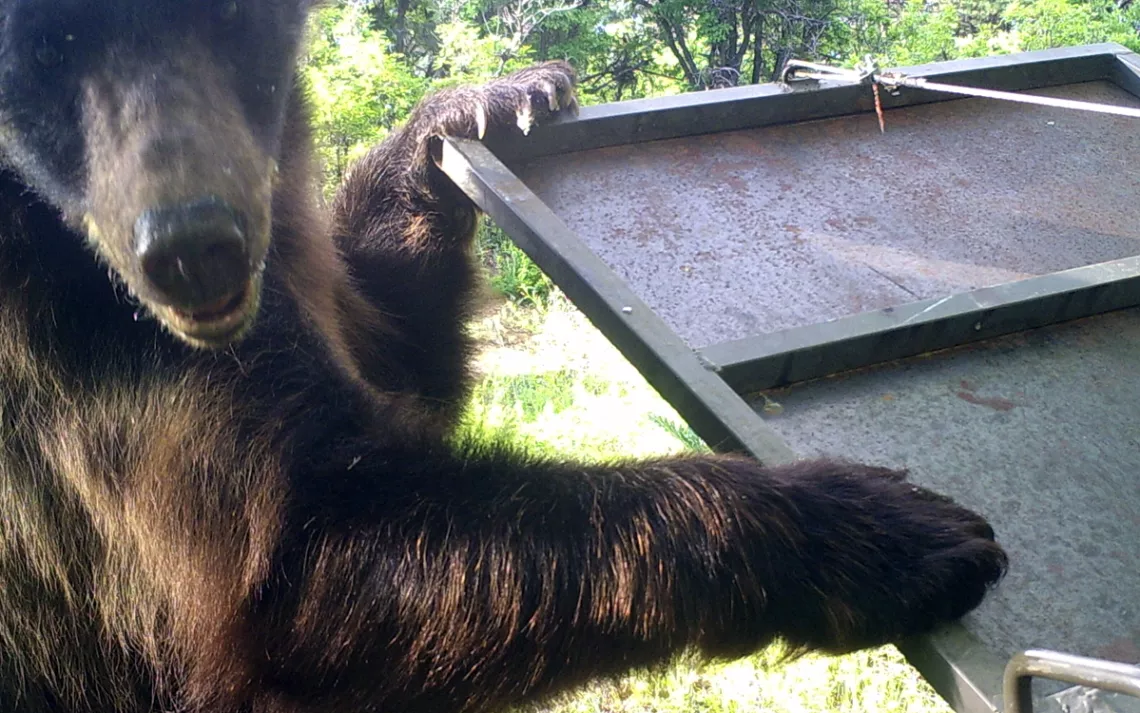
Bear exploring a research trap | Photo courtesy of Colorado Parks and Wildlife
Last January, a small Colorado town called Mountain Village received an unexpected visitor: a young black bear strolling down the town’s main street. Bears had made an appearance in Mountain Village before, but the timing was off—this bear was out and about during the dead of winter, when black bears are typically fast asleep in their dens.
Midwinter bear sightings may become an even more common occurrence in years to come. A study based out of Durango, Colorado—50 miles south of Mountain Village—tracked the movements of nearby female black bears and found that while Durango-area bears went to sleep in October or November and stayed in their dens until early spring, several factors shortened their hibernation, including warmer temperatures and a penchant for foraging through dumpsters and trash cans.
In bountiful years, bears often put off hibernation for a few days to take advantage of the smorgasbord. Similarly, if there’s a food shortage, bears go to den early and sleep until spring, when the plants grow new berries and nuts. But human food in trash cans and dumpsters may be changing the equation, because it’s available year-round. "Bears will stay out as long as they can, as long as there’s food,” says the study’s lead author, Heather E. Johnson, formerly of Colorado Parks and Wildlife and now working for the USGS.
Bears that spend more time foraging in human towns are “the last bears standing," Johnson says. “They’re the last bears that are still out, milling around.” This delayed hibernation could make it seem like the bear population in an area is increasing, says Johnson, but her own research suggests that’s not necessarily the case.
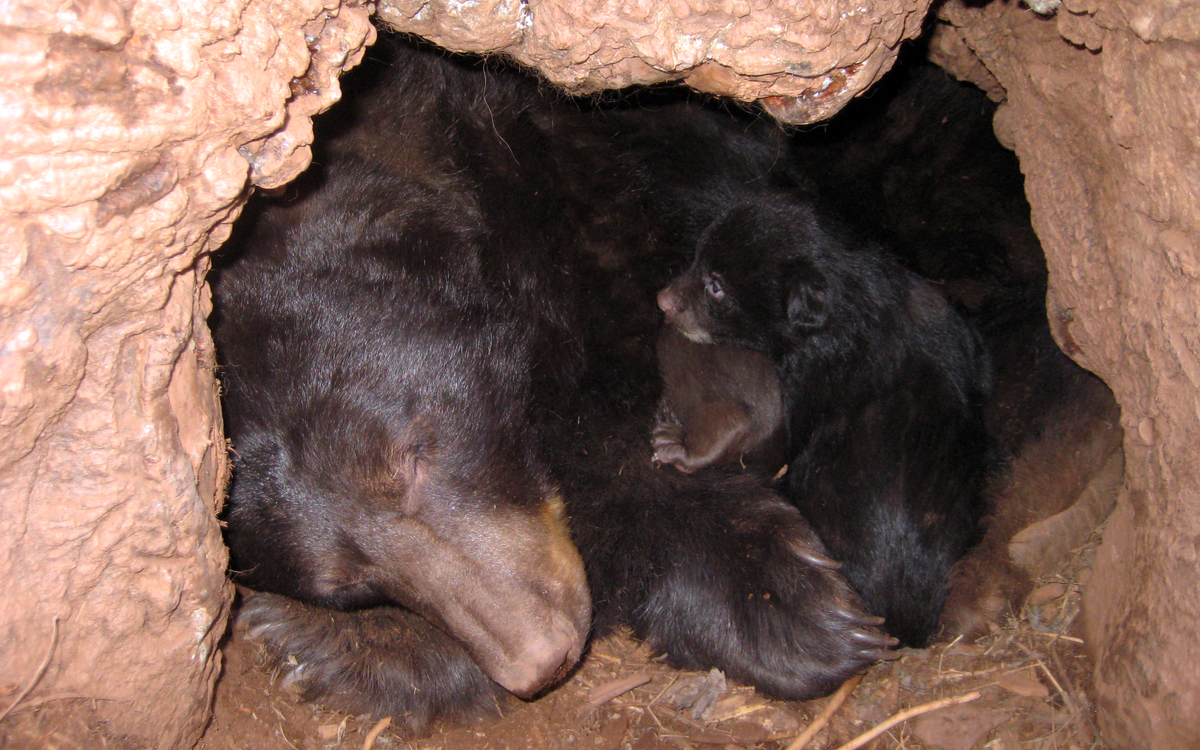
Colorado is getting warmer. In the last century, most of the state warmed by one or two degrees, and temperatures are projected to keep rising. The human population also shows no signs of declining—Colorado is the eighth-fastest-growing U.S. state. Climate change and the expansion of housing into formerly wild areas could be causing an increase in the number of human-bear run-ins—which often end with bears being killed or euthanized.
However, veteran bear expert Dave Garshelis of the Minnesota Department of Natural Resources, who was not involved in the Durango study, isn’t convinced that higher temperatures will lead to more human-bear conflicts. He points out that black bears in warm regions such as Florida and New Mexico hibernate much less (and sometimes not at all), but those areas don’t see especially high numbers of confrontations between bears and humans. Regions that experience more rainfall as a result of climate change could see fewer of the wild food shortages that drive bears into human towns.
“They’re saying that the bears will be active longer, [and assuming] that the foods will be essentially the same. But what’s driving the conflicts is the food. . . . You can’t say that all of this [climate variability] is going to have zero effect on the foods in the summer,” Garshelis says.
However, Johnson points out that climate change also may lead to more frequent wild food shortages in some parts of bear country. In Colorado, many of the worst years for human-bear conflicts have been years when a “late hard freeze”—a sudden cold snap in the spring—froze all the flowers, eliminating the wild berries and fruits that bears rely on. In 2017, a late frost in June followed by a summer drought set the stage for one of the worst years for Colorado’s bears in recent memory. Thirty-six bears were euthanized in La Plata County (where Durango is located) alone.
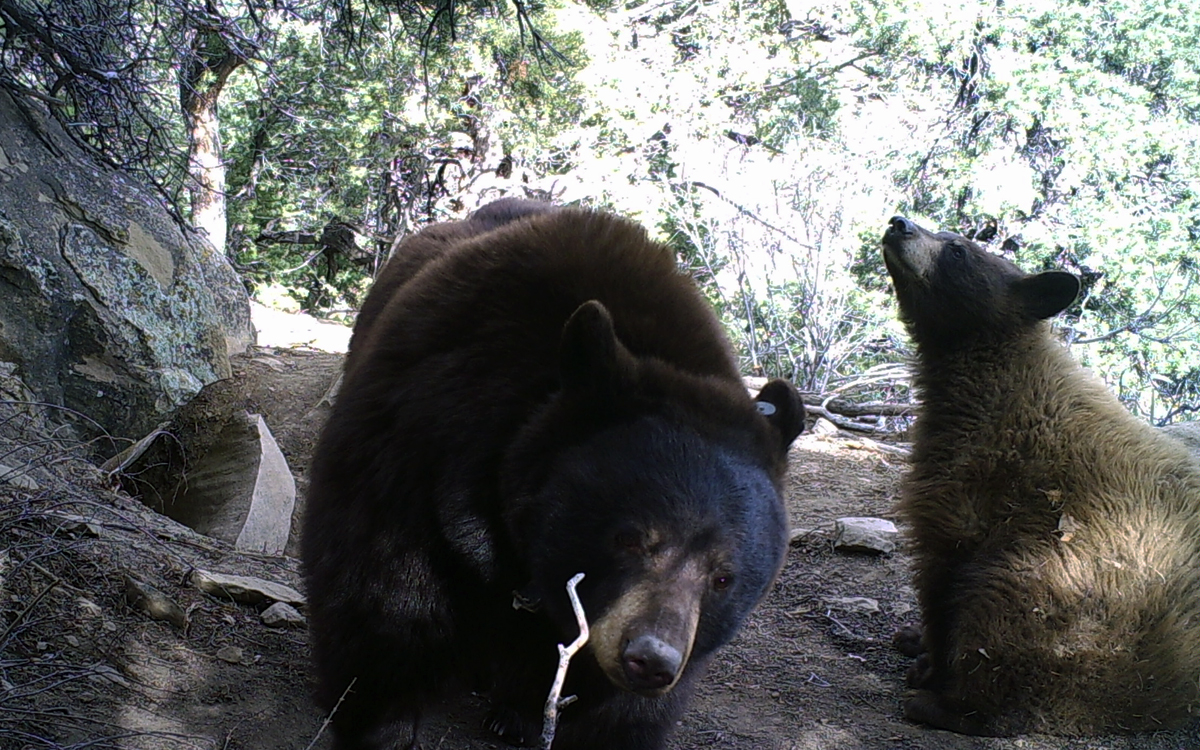
One solution: bear-resistant garbage cans and dumpsters. Many towns and conservation organizations encourage using bear-resistant containers, but few mandate it. If humans stash all their extra food in bear-resistant containers, wakeful bears will have a more difficult time scrounging for human food and will likely spend less time in human neighborhoods.
No ordinary garbage can will suffice. To be certified bear-resistant by the Interagency Grizzly Bear Committee, a container must survive at least an hour of being thrown, bitten, battered, jumped on, and punched by bears. The independent not-for-profit Grizzly and Wolf Discovery Center, located just outside of (but not affiliated with) Yellowstone National Park, houses rescue bears that have become too attracted to human food to live safely in the wild, and many of the center’s bears have a product-testing day job. The staff presents them with coolers, sleeping bags, and garbage containers stuffed with snacks and time how long it takes the ursine product testers to make a hole in the product.
Last year, the Discovery Center bears tested 12 different residential garbage cans. Out of the 12, only three passed. Discovery Center staff say that while manufacturers are getting better at making bear-resistant products, it’s hard to make a bear-resistant garbage can that’s also lightweight and user friendly. Even the best product isn’t indestructible. “We do use the word ‘bear-resistant’ rather than ‘bear-proof,'” says the Discovery Center facilities manager, Randy Gravatt. “We think that if you give a bear an unlimited amount of time, they will eventually get into most products.”
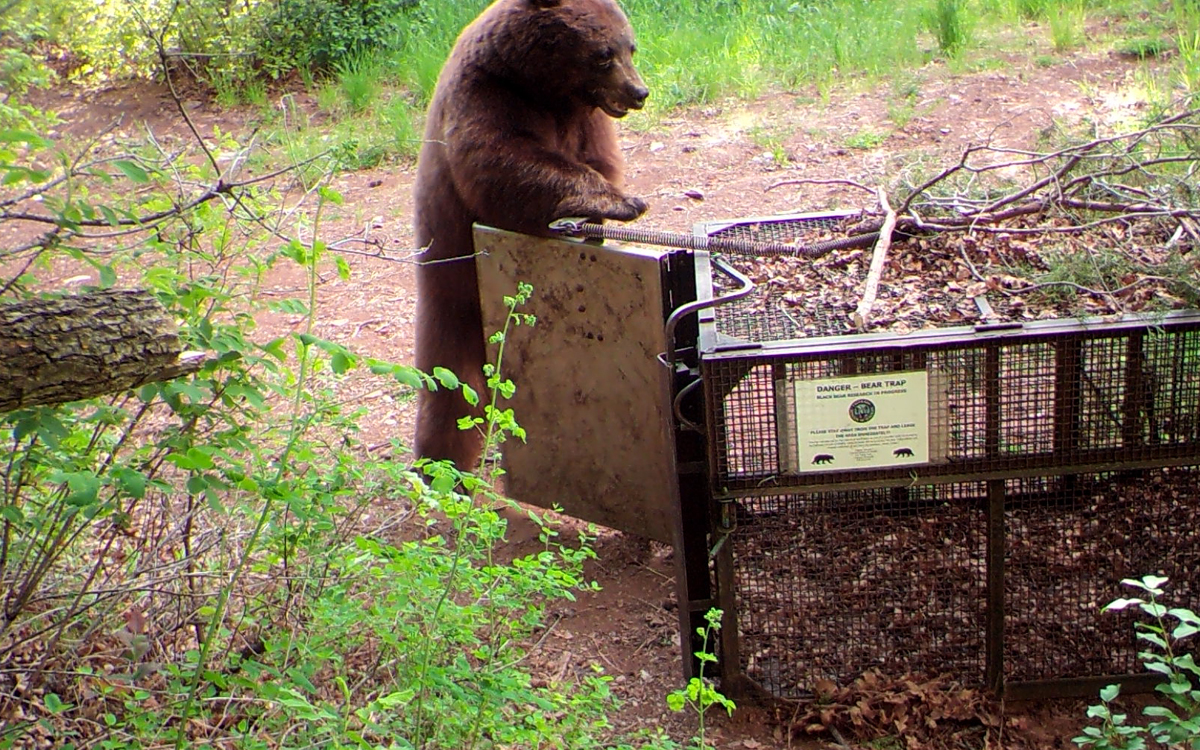
Researchers worked with the city of Durango to distribute over 1,100 bear-resistant garbage containers to residents but struggled to get residents to use them as intended. The bear-resistant trash can experiment in Durango found that far fewer human-bear conflicts occurred in neighborhoods where at least 60 percent of households secured their trash. Before Durango began handing out bear-resistant containers, only 10 percent of the residents in that area were using bear-proof canisters already.
Reaching 60 percent compliance is easier said than done. Three monthly inspections over the course of the summer by researchers before garbage pickup found that only 27 percent of households had remembered to lock their trash cans on all three occasions. Thirty-nine percent didn’t have their trash locked up on any of the days the researchers checked. The takeaway was that while 60 percent compliance is a relatively achievable number, many neighborhoods weren’t there yet, and many people were inconsistent about locking up their trash.
Social science researcher Stacy Lischka of Colorado State University conducted a mail survey to find out why some Durango residents used the bear-resistant containers and others didn’t. Age, education level, and other demographic factors didn’t seem to matter much. Instead, the people least likely to lock up their trash were the ones with the most faith in the Colorado Parks and Wildlife Department. Residents who thought state and local wildlife management were already doing a good job were less likely to think their own garbage handling would make a difference. “If Parks and Wildlife turns around and says, ‘We can’t do our job without you playing this critical individual role and keeping your garbage locked up,’ that can build on that trust piece,” Lischka says.
Another key factor that influenced people’s likelihood of locking up trash was their overall opinion of bears. “If we incorporate some of the information about the benefits of bears [into outreach campaigns], we actually increase people’s tolerance for them,” Lischka says. Spreading seeds and controlling insect populations are just two of the ecological benefits of having black bears around, but not everyone sees them as assets to the neighborhood. Keeping black bears out of human neighborhoods is just as much for the bears’ protection as it is for the humans’, so positive publicity and public education could go a long way to reduce the human-bear conflict rate.
Garshelis points to the changing attitudes toward bears as one reason that people shouldn’t assume warmer temperatures or higher amounts of winter bear activity will automatically lead to an increase in bear conflicts. For an incident to count as a human-bear conflict, a person has to react negatively to something the bear did. So a toppled trash can does not a conflict make, unless a human gets upset about it. Up until the 1960s, American black bears were in decline, due to hunting and habitat loss. And as recently as the 1980s, it wasn’t unusual for homeowners to shoot bears dead over very mild property damage.
“Nowadays, publicly it would be disdained upon, and you could probably get ticketed for doing that. You’re allowed to shoot bears if they threaten your property, but if it just tips over your garbage can, that’s not considered a reason to shoot the bear [anymore],” Garshelis says. Policies on how to handle dumpster-diving ursines vary widely by state. Today, many bears are tranqed and forcibly relocated rather than shot dead.
Today, populations across the country are rebounding because of changes to hunting laws, environmental education, and increased efforts to conserve bears’ habitats. Garshelis says that if the trends toward increased empathy for bears and greater recognition of bears’ role in ecosystems continue, increased tolerance for bears might cause the number of human-bear conflicts to fall, even if more bears are roaming during winter months.
However, human communities still have a long way to go in terms of educating people about bears and making sure that people in bear country are diligent about securing their food and garbage. In 2017, the city of Durango gave another 400 bear-resistant garbage containers to residents and plans to distribute an additional 500 cans in 2018.
“I think there’s a perception that bears live in the mountains, people live in the valleys, and they live in separate places. . . . But especially as landscapes become more developed, that’s just not likely,” Johnson says. “As the landscapes get more and more developed, we need to focus on thinking about how to coexist.”
 The Magazine of The Sierra Club
The Magazine of The Sierra Club

